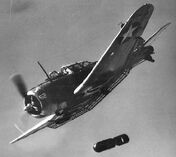The SBD Dauntless or A-24 Banshee (as it was known during use by the United States Army) was a dive bomber used by the United States during World War II.
Description[]
It had a 1,200 hp,air-cooled, Wright R-1820-60 Engine capable of propelling the Dauntless at speeds of up to 410 km/h.[1] The propeller of the Dauntless had only three blades. It also had a crew of two and an armament of 2x .50 M2 Machine guns mounted in the nose of the aircraft, one .30 Browning M1919 MG mounted in the gunner position and up to 1,020.58 kg of bombs.
The max range of the SBD was 1,795 kilometers and the rate of climb of 8.6 m/sec. The unloaded weight of the Dauntless was 2,905 kg and the length was 10.09 meters. The service ceiling for the SBD was about 8,260 meters and the dive brakes were punched with 7.62 cm holes.[2] One of the SBD's most unusual facts about designing was that it lacked folding wings that were used with other carrier aircraft. The title of the Dauntless was not unusual nor random and was created from the beginning letters of the company and aircraft type. For example, the "SB" from the title SBD stands for Scout Bomber while "D" stands for Douglas.
Variants[]
The Douglas SBD Dauntless had a number of variants that improved upon the original design which had several bad qualities. The first of these variants was the Douglas SBD-1P which were reconnaissance planes that were converted from the original SBD-1.[3] The next variant was the SBD-2 which had increased fuel capacity and a revised armament. Despite having more fuel capacity, the SBD-2 did not have the self-sealing fuel tanks that would later be applied to other SBD variants. The SBD-2P variant is virtually the same to the SBD-1P as it is a reconnaissance plane except it is based on the SBD-2. The SBD-3, the next variant, was the first variant to have self-sealing fuel tanks and it had additional armor added. It also had two .30 MGs mounted in the gunner position along with the usual dual .50 MGs in the nose.
The last reconnaissance variant of the SBD was the SBD-3 which was practically the same as the other reconnaissance planes only it was based on the SBD-3. The SBD-4, SBD-5, and the SBD-6 all had minor modifications that improved on the previous designs. The SBD-4 had improved electronics, the SBD-5 had an improved engine plus more ammunition, and the SBD-6 also had an improved engine. For army use, the SBD Dauntless was fairly modified in that it had no navy equipment or tail hook. The A-24A and the A-24B were based on the SBD-4 and SBD-5, the only difference being their lack of navy equipment.

An SBD dropping its bomb
History[]
The first prototype of the SBD was the XBT-1 and it was refitted with a new engine which gave it the new designation BT-1. The BT-1 with some major modifications became the XBT-2 which then was redesignated the SBD-1 when it was accepted. The SBD was fairly effective in combat and was used extensively throughout the war. Although, over time it was replaced by newer, more effective light bombers. A sign of this effectiveness despite its age, is the SBD's nickname, "Slow but Deadly". Another sign of the SBD's effectiveness was that it sank more Japanese ships in the Pacific campaign then any other allied aircraft.[4] In fact, during the Battle of Midway, all four Japanese carriers were put out of action by SBD dive bombers. The SBD also served during the Battle of Guadalcanal. The SBD and all of its variants ended production in 1944.
References[]
| |||||||||||||||||||||||
